DHRANGADHRA
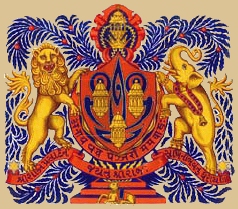
BRIEF HISTORY
Rana Waghoji succeeded in 1469, but rebelled against the Muslim power. The Sultan of Gujarat sent Khalil Khan against him, but Waghoji succeeded in defeating that prince. In 1486, the Sultan took the field to chastise Waghoji himself, arrived at Kuwa and laid seige to the fort. When supplies were about to run out in the town, Waghoji ordered fires to be lit and told his wives to prepare for sati, then sallied forth to do battle against the enemy. During the conflict his standard bearer tired of carrying his burden and temporarily put down his ensign. This act prompted the poor Ranis to imagine the death of their lord, and each of them dutifully mounted the pyre. Waghoji returned to the fort to find them all dead. Disconsulate, he vowed to die fighting in battle and rode out again into the thick of the enemy. He killed many in close combat, until eventually he succumbd to their swords. The Sultan's forcees invaded the fort, ransacked and destroyed Kuwa.
Rajodharji [Raydharji] established a new capital at Halvad in Kathiawar in 1488. Maharaja Jaswant Singhji I of Jodhpur, the Mughal Viceroy of Gujarat, annexed Halvad from Maharana Jaswantsinhji I in 1673 and made it into an imperial jagir. Maharana Chandrasinhji of Wankaner wrested control of Halvad from its Muslim jagirdar in 1679, but yielded it to Jaswantsinhji I in the following year. Emperor Aurangzeb confirmed Jaswantsinhji in his possessions by an Imperial sanad in October 1680. Jaswantsinhji II removed his capital permanently to Dhrangadhra in 1783.
Although the family held the state uninterruptedly after 1783, frequent quarrells and disputes over the succession and over territory coninued to plague the clan for the next century and a half. The enmity and feuding reached such a state that in 1805 Wadhwan and Dhrangadhra battled with each other over a goat. Eventually, this period of conflict was brought to an end by the Walker settlement of 1807-1808. Thereafter, the peace afforded by the settlement ensured that the Jhala rulers could concenrate on improving he lot of their subjects.
Luckily for the people of Dhrangadhra, they basked under the benevolent rule of five successive rulers who took their interests to heart. Grea imporvements in education, irrigation, administrative and judicial reform, as well as investmens in indusry and agriculture ensued over the next 150 years. Maharanas Ranmalsinghji, Mansinhji II, Ajitsinhji, Ghanshyamsinhji and Megrajji III all excelled as enlightened rulers. Most engrossed themselves in intellectual pursuits and thus prized education and learning for their subjects. After sixty years of school building, the state provided both primary and secondary education during the first decade of the twentieth century. This interest in education did not limit itself to Dhrangadhra, as the Maharana's also assisted their subjects obtain tertiary and higher educational qualifications in the major institutions outside the state, in metropolitan universities and abroad. The legacy of that interest can even be seen in England today. The foundations of Millfield school stem from the school established by Maharana Ghanshyamsinjhi for the education of his sons and those of his relatives.
Apart from education, the Maharana Ghanshyamsinjhi also took a great interest in agricultural and industrial development. The salt industry, which provided a large portion of stat revenues, saw a great expansion. Industrial and chemical plants were consruted to produce related and value added products. This industry remains the major industry in Dhragadhra to this day.
SALUTE:
11-guns.
ARMS:
Murrey, three canopied niches or. Crest: a hand clenched proper vested or. Supporters: Brahmini bulls proper. Motto: "Anatha Vajra Panjaro Mama Bahu" (My arm an adamant shelter for the helpless). Lambrequins: Murrey and or.
In the centre, the escutcheon bearing the dual device of the oriels and the cypher, this encircled by a girdle, bearing the motto: the escutcheon draped atop by the flag, surmounted by a crown, above the crown again the flag unfurled displaying the crest; that is another oriel and the festoon, all this supported on the dexter by a lion and on the sinister by an elephant; under these supporters and the escutcheon a scroll bearing the invocation, below this scroll and in the centre, a fire with a seated bull in the front facing dexter, a tree originating from behind the escutcheon and with branches spreading on either side above and below the supporters, and bearing the fruit and leaves.
FLAG:
A rectangular pink flag with 3 oriels (2,1) in yellow, with dark-blue openings and background.
STYLES & TITLES:
The ruling prince: Shri Shaktimant Jhaladipati Mahamandleshwar Maharana Sriraj (personal name) (father's name) Sahib, Maharaja Raj Sahib of Dhrangadhra-Halvad, with the style of His Highness.
The consort of the ruling prince:
The Heir Apparent: Patvi Namdar Jhalavrit Maharajkumar Shri (personal name) (father's name) Sahib, Yuvraj of Dhrangadhra-Halvad
The younger sons of the ruling prince: Maharajkumar Shri (personal name) (father's name) Sahib.
The daughters of the ruling prince: Maharajkumari Baiji Lal Shri (personal name) Kunverba Sahib.
Other male descendants of previous ruling princes, in the male line: Raj Rana Shri (personal name) (father's name) Sahib.
Other female descendants of previous ruling princes, in the male line: Baiji Lal Shri (personal name) Kunverba Sahib.
ORDERS & DECORATIONS:
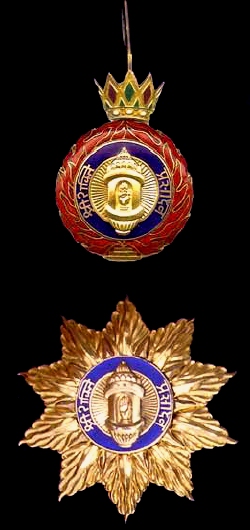
The Sri Shaktimant Makhapraphulla Order - first class, neck badge (A) and breast badge (B).
The Sri Shaktimant Makhapraphulla Order of Jhalavad: founded by Maharana Sriraj Sir Ajitsinhji Jaswantwinhji Sahib Bahadur in 1933 and received its statutes from Maharana Sriraj Meghrajji III on 11th November 1947 (revised 25th March 1948). Awarded in three classes (1. First class - a breast star in gold and enamel with a gold neck badge fully enamelled in red, blue and green. 2. Second class - a breast star in silver, silver-gilt and blue enamel with a silver-gilt neck badge partially enamelled in blue. 3. Third class - a silver-gilt neck badge partially enamelled in blue).

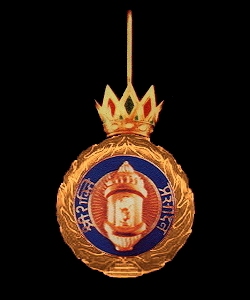
The Shaktimant Order - second class, breast star (L) and neck badge (R).
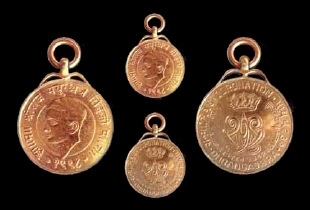
The Rajyabhisek Medal, third class in bronze - obverse (L), miniature obverse & reverse (C) and reverse (R).
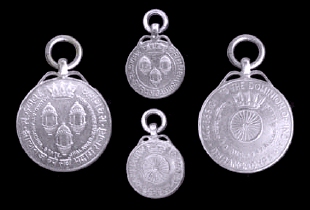
The Dhrangadhra Accession Medal - obverse (L), miniature obverse & reverse (C) and reverse (R).
Male primogeniture, with the right of adoption by the recognised head of the family on the failure of natural male heirs.
SOURCES:
John Borneman (Princeton University) and Parvis Ghassem-Fachandi. Audience with the Maharaja of a Saurashtrian Princely State. Internet. Posted: December 06, 2002
Chiefs and Leading Families in Rajputana (The Ruling Princes, Chiefs and Leading Personages in Rajputana and Ajmer). Office of the Superintendent of Government Printing, Calcutta, 1894, 1903, 1912, 1916 and 1935.
Alexander Kinloch Forbes. Ras-Mala, Hindu Annals of Western India, with particular reference to Gujarat. Heritage Publishers. New Delhi, 1973.
Gazetteer of the Bombay Presidency. Volume VIII. Kathiawar. Government of Bombay, Bombay, 1884.
C. Mayne. History of Dhrangadhra State. Thacker, Spink & Co., Calcutta and Simla, 1921.
Memoranda on The Indian States 1940 (Corrected up to the 1st January 1940). Manager of Publication, Government of India, Delhi, 1940.
The Rajputana Gazetteer. Volume II. Office of the Superintendent of Government Printing, Calcutta, 1879.
Royal Millfield Genesis - a Saga Recalled by MGJ. 1993/99. Revised and Amplified to include a Supplement on the Millfield Diamond Jubilee. Rajman Research Bureau, Rajmahal, Dhrangadhra, Jhalavad, Saurasthra, Gujarat - 363310.
The Ruling Princes, Chiefs and Leading Personages in the Western India States Agency, 1st edition. Rajkot, 1928.
The Ruling Princes, Chiefs and Leading Personages in the Western India States Agency, 2nd edition. Manager of Publications, Delhi, 1935.
Vidyanand Swami Shrivastavya (author), & K. Shrivastavya (editor). Parmars of Abu Chandravati and their Descendants, in four parts. Aitihasik Gaurav Grantha Mala, Muzaffarpur, Behar, 1953.
Thacker's Indian Directory. Thacker's Press & Directories, Ltd., Calcutta 1863-1956.
A. Vadivelu, The Ruling Chiefs, Nobles & Zamindars of India. G.C. Loganadham Bros., Madras, 1915.
Capt. H. Wilberforce-Bell. The History of Kathiawad, from the earliest times. William Heinemann, London, 1916.
* Jhala, Angma and Jhala, Jayasinhji. Genealogy, Archive, Image: Interpreting Dynastic History in Western India, c.1090-2016. Walter de Gruyter GmbH & Co KG, Berlin, Germany (April 2017) - It is with regret that we point out that the authors of this publication “borrow” extensively from our website, without the slightest acknowledgement of our work. Whether by carelessness, oversight or intentional plagiarism we cannot be entirely certain. If it is the latter, while there appears to have been a certain level of diligence in attempting to cover up the deception, laziness has overcome diligence in several glaring instances. Outright, word for word reproduction of our text finds its way into theirs. Even sections of the bibliography and abbreviations have simply been copied and reproduced; our formats used, syntax replicated, even the same errors duplicated. For those parts not copied from here, “lapses” of fact abound. There are, to mention just a brief example, lists of marriages with the “Rathor of Gadh Idar” (presumably Pol/Vijaynagar), “Gohil of Gadh Rijpipla” and “Sesodia (sic!) of Dungarpur”, supposedly taking place centuries before those families are known to have established themselves in those parts or the towns erected. Caveat emptor!
SPECIAL ACKNOWLEDGEMENTS:
H.H. Maharana Sriraj Meghrajji III, Maharaja Raj Sahib of Dhrangadhra-Halvad, KCIE.
Kumar Shri Narayansinhji Jhala of Hampur.
Sahibzada Taimur Khan Palanpur.
Sudhir K. Patel.
Copyright@Christopher Buyers, March 2007 - July 2022